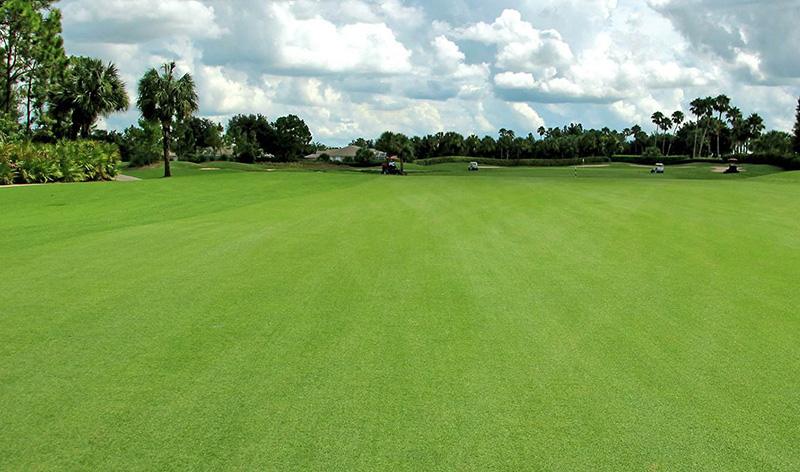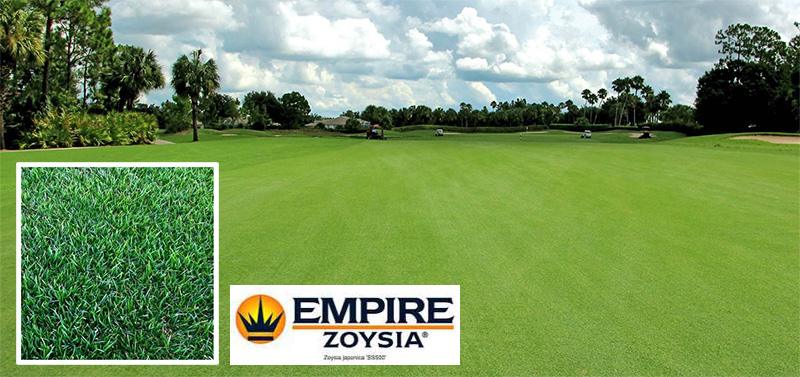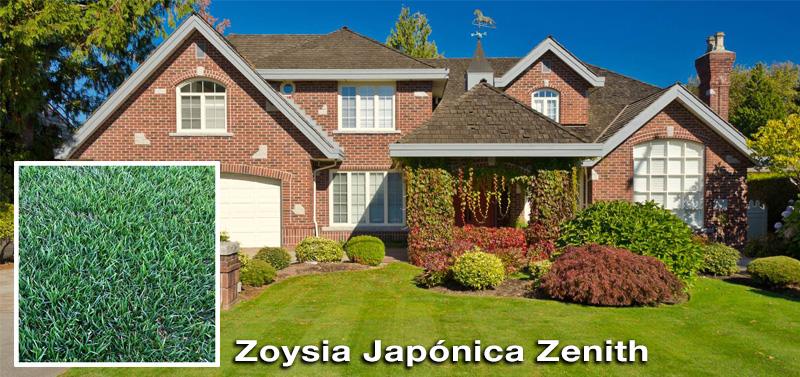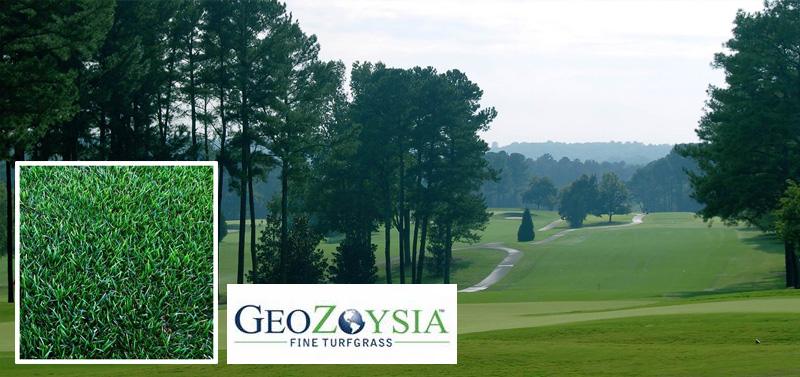A warm-weather grass native to Southeast Asia, Zoysia (Zoysia spp.) has recently gained popularity in Spain.
A slow-growing, low-cut grass, Zoysia produces sod capable of forming a dense covering that is resistant to trampling, and grows well in total sunlight or partial shade. It requires less mowing and fertilization than Bermuda grass, is more resistant to mowing, and is easier to keep away from weeds due to its density.
However, once this variety comes in contact with a meadow, it is difficult to control, since Zoysia tolerates selective herbicides relatively well.
Zoysia is well adapted to the warm areas of Spain, and is usually planted as sod. Seed species are available, but they may lose some of their desirable characteristics with respect to sod-forming cultivars.
Before starting with the annual maintenance plan, we recommend performing a soil analysis that covers pH, phosphorus levels, potassium levels, etc. Adequate soil is necessary to produce a healthy, attractive and high quality surface. Zoysia will tolerate a wide pH range, but prefers soils with a pH between 5.8-6.5.
Once Zoysia sod is established, it can form a thatch (accumulation of dead and decaying residues of the plant on the surface of the soil), especially when infrequent mowing is done at high altitudes or when it is over-fertilized or over-irrigated. It’s necessary to remove the thatch every 2-3 years through aeration (punctured or scarified), but be careful, since Zoysia has a very slow recovery rate.
Zoysia performs best when mowed with spiral machinery, although good results are also achieved when a properly sharpened rotary mower is used. You should cut as low as possible without scaling, which damages the plant. Uneven terrain may make it difficult to mow Zoysia at the preferred low level.
In Spain, we can find Zoysia varieties such as Geo, Empire, Zenith, and Zeon.
Zoysia is susceptible to diseases such as rust, white mold (Sclerotinia spp.), and large patch (Rhizoctonia spp.), which is sometimes called brown patch or zoysia patch.
ZOYSIA MAINTENANCE CALENDAR
The following table shows the optimal time period to perform maintenance practices. The optimal maintenance period may begin earlier or last longer due to weather changes in the study area.
A shows acceptable months for the designated task
B shows the best months for the designated task
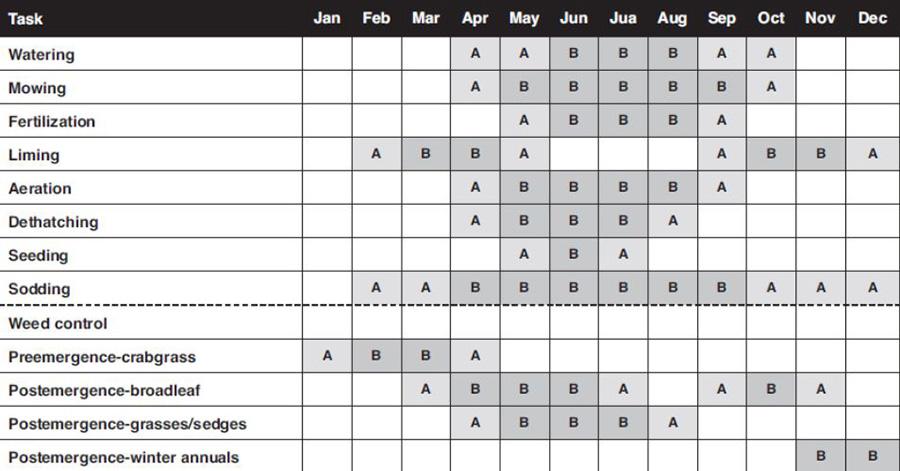
TASKS FROM MARCH TO MAY
- MOWING:
Before Zoysia begins to grow in the spring, the grass should be mowed slightly shorter than usual. Any mowing remains and debris should be removed. This will reduce shading the growing plants and will also help heat the soil more quickly in spring. Emerging green stems should be carefully checked before removing the remains of dead leaves. Zoysia often doesn’t often go completely dormant winter like Bermuda grass. Mowing should begin when the grass turns green in the spring. Zoysia should be cut between 19 and 60 mm. Higher heights may be necessary on uneven surfaces to avoid scalping. Mow frequently to avoid eliminating more than 1/3 of the leaf at one time. It isn’t necessary to collect the mowing remains unless they form “tufts” on the lawn.
- FERTILIZATION:
Apply 0.25 kg of nitrogen per 100 m2 approximately three weeks after the grass turns green (at the end of May). If it hasn’t been done previously, perform a soil analysis to determine the phosphorus and potassium requirements. Apply lime if necessary.
Do not apply more than 1 kg of nitrogen per 100 m2 per year.
- WATERING:
On very specific occasions, it’s necessary to water the Zosyia in the spring, except for recently sodded areas or if there are hot, dry and windy conditions for a long period of time. A bluish gray color, footprints, wilting, and bent, curved leaves indicate that it is time to water. Adequate watering can prevent pest problems and water stress in the summer. - DISEASE CONTROL:
Circular brown spots may indicate brown patch (Rhizoctonia spp.). Brown patch is difficult to control with fungicides. A better method is to improve drainage and air movement, and reduce the amount of nitrogen and watering. - WEED CONTROL:
Apply pre-emergent herbicides to control crabgrass at the end of February or the beginning of March. Control the emergence of broadleaf weeds with post-emergent herbicides 2,4-D + Dicamba and/or MCPP (depending on what the laws in each country allow). Do not exceed two applications per year and always allow at least 30 days between treatments. To control Cyperus in post-emergence, use Halosulfuron. - INSECT CONTROL:
Check for insects and treat if necessary. - RENEWAL:
Replant large areas using sod or cuttings planted every 15-30 cm. The application of a pre-emergent herbicide that doesn’t interfere with the growth of the roots after cuttings have been planted helps prevent weed invasions.
TASKS FROM JUNE TO AUGUST
- MOWING:
The Zoysia should be cut every five to seven days, and more often when the ground is suffering from water stress. - FERTILIZATION:
Apply 0.25-0.35 kg of nitrogen per 100 m2 at the end of June or beginning of July, and repeat in mid-August. Do not apply more than 1 kg of nitrogen per 100 m2 per year. - WATERING:
Water early in the morning to moisten the soil at a depth of 10-15 cm. The Zoysia needs a weekly application of 25-30 l/m2 to maintain its color during the summer. To simply survive, Zoysia needs even less, and it can go several weeks without watering. In sandy soils, it requires more frequent watering, such as 12 l/m2 every three days. Because clay soils accept less water, water those areas until runoff occurs, wait half an hour until the water is absorbed, and continue to apply the total amount desired. A bluish gray color, footprints, wilting, and bent/curved leaves indicate that it is time to water. - CULTIVATION PROCEDURES:
The waterbed needs to be removed every 2-3 years via puncturing or scarification. The ideal time to remove waterbeds is at the beginning of the summer, since the humidity is not limiting, and the (moment of growth is optimal for recovery. - DISEASE CONTROL:
Zoysia can suffer from rust in the summer. Since rust causes only minor damage, fungicide application is not recommended. Increasing fertilization with nitrogen during those months prevents the appearance of rust. - WEED CONTROL:
Control the emergence of broadleaf weeds with post-emergent herbicides 2,4-D + Dicamba and/or MCPP (depending on what the legislation of each country allows). Do not exceed two applications per year of these products, and always allow at least 30 days between treatments. To control Cyperus in post-emergence, use Halosulfuron. Apply post-emergent herbicides only when weeds are present, the grass is actively growing, and is not suffering from water stress. To improve annual meadow-grass control, apply a pre-emergent herbicide on August 15 and water immediately. - INSECT CONTROL:
Check for insects and treat if necessary. - RENEWAL:
Replant large areas using sod or cuttings planted every 15-30 cm. The sod will settle faster in summer than in spring. Keep the new sod wet for the next two weeks after laying.
TASKS FROM SEPTEMBER TO NOVEMBER
- MOWING:
Zoysia should be cut every 5-7 days; fewer cuts will result in low-quality grass. Zoysia in shaded areas can be cut slightly higher than Zoysia in direct sunlight. It’s not necessary to remove the mowing remains unless they block the sunlight. - FERTILIZATION:
Do not fertilize with nitrogen. Potassium can be applied if soil analyses indicate that it is necessary. - WATER:
Follow the indication from March to May. - DISEASE CONTROL:
If there are circular brown spots of a certain size, they may be brown patch (Rhizoctonia spp.). Control of this disease with fungicides is complicated. A better method is to improve drainage, air movement, and to reduce the amount of nitrogen and watering. If the attack is severe, a fungicide application may be required, preferably between 2- 4 weeks before the plant goes dormant. - WEED CONTROL:
Control the emergence of broadleaf weeds with post-emergent herbicides 2,4-D + Dicamba and/or MCPP (depending on what the laws in each country allow). Do not exceed two applications per year, and always allow at least 30 days between treatments.
TASKS FROM DECEMBER TO FEBRUARY
- FERTILIZATION:
Do not fertilize. Send soil samples every 2 – 3 years to determine the necessary requirements. - WATERING:
Planting of new sod may require watering to prevent drying, especially when dry and windy conditions are present. - WEED CONTROL:
Do not use glyphosate to control weeds in winter. Unlike Bermuda grass, Zoysia never goes completely dormant. Control the emergence of broadleaf weeds with post-emergent herbicides 2,4-D + Dicamba and/or MCPP (depending on what the laws in each country allow). Do not exceed two applications per year, and always allow at least 30 days between treatments.
Jaime Linares
Southern Area Technical/Commercial Department

